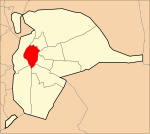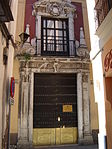Monastery of San Clemente (Sevilla)
Bien de Interés Cultural landmarks in the Province of SevilleChristian monasteries established in the 16th centuryChristian monasteries in SpainSpanish Christian monastery stubs

Monastery of San Clemente (Monasterio de San Clemente) is a Cistercian monastery with the Bien de Interés Cultural designation in the Spanish city of Seville. Architecturally, it is a heterogeneous set of buildings, built in different times and styles, from the 16th to the 17th century.
Excerpt from the Wikipedia article Monastery of San Clemente (Sevilla) (License: CC BY-SA 3.0, Authors, Images).Monastery of San Clemente (Sevilla)
Calle Torneo, Seville Casco Antiguo
Geographical coordinates (GPS) Address External links Nearby Places Show on map
Geographical coordinates (GPS)
| Latitude | Longitude |
|---|---|
| N 37.402542 ° | E -5.995472 ° |
Address
Real Monasterio de San Clemente
Calle Torneo
41002 Seville, Casco Antiguo
Andalusia, Spain
Open on Google Maps











